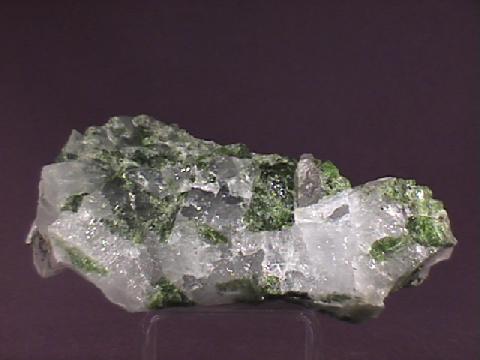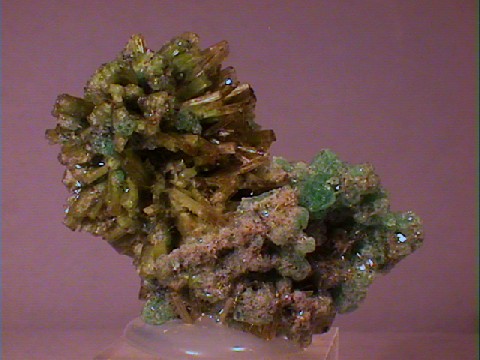
DIOPSIDE
Specimen dps-13
$ 25.00
Dims:2.0x1.7x0.7" (5.1x4.3x1.8 cm)
Wt: 1.7oz. (48g)
Jeffrey Mine, Asbestos, Quebec, Canada
This specimen consists of dozens of prismatic diopside crystals growing from a piece of matrix material. At least two of these crystals are double terminated; the largest crystal measures just under 1.0" (2.5cm) in length. These diopsides are highly translucent, and a beautiful shade of brown. There is minor damage around the edges of this specimen, and some abrasion damage to the crystals on one side.
 Amethyst Galleries' Mineral Gallery MINERALS |

DIOPSIDE specimen dps-1
$ 80.00
$ 80.00
Dims: 3.2" x 2.5" x 1.6" (8.1 x 6.4 x 4.1 cm)
Wt: 11.4 oz. (322 g)
Butte, Montana, U.S.A.
This rather dense hand specimen consists of countless intergrown Diopside crystals that make up the bulk of the piece. Most of them are broken, as the specimen appears to have been broken out of a larger piece of the same material. There are some monoclinic prismatic crystals that show no damage, though, and these have reasonably good form, though they are somewhat warped and incomplete due to the intense intergrowth. They still have well-defined edges and smooth faces that show a pearly luster. Their color is a moderately pale forest-green, and they are all translucent; some could conceivably be transparent, but they are so heavily internally fractured that any clarity is destroyed. Any large hollows in between the crystals are filled with a pale blue calcite, and there are patches of a heavily worn, cream-colored mineral in places, but I cannot identify it.


dps-1 ($ 80.00)
Butte, Montana, U.S.A.

DIOPSIDE specimen dps-2
$ 60.00
$ 60.00
Dims: 2.9" x 2.4" x 1.8" (7.4 x 6.1 x 4.6 cm)
Wt: 7.91 oz. (224.4 g)
Butte, Montana, U.S.A.
This specimen is made up mostly of intergrown Diopside crystals, almost all of which are intergrown and broken. There are a few hollows in one area of the host rock, however, and several complete and intact crystals are visible there. They achieve maximum dimensions of 0.4 x 0.2 x 0.2" (1.0 x 0.5 x 0.5 cm) and show a slightly rounded but definite monoclinic prismatic form that almost looks like a tetragonal dipyramid in a few of the crystals. Their color is a moderately pale green with a hint of gray and they show a pearly luster. A few may show some dim translucence, but they are, for the most part, opaque. The hollows that contain the intact crystals are mostly filled with amorphous, pale blue calcite- the intact Diopsides were enveloped by it after their formation, and were thus protected.


dps-2 ($ 60.00)
Butte, Montana, U.S.A.

$ 140.00
Dims: 3.0" x 2.5" x 1.1" (7.6 x 6.4 x 2.8 cm)
Wt: 5.37 oz. (152.2 g)
Jeffrey Mine, Asbestos, Quebec, Canada
Dozens of thin, monoclinic prismatic Diopside crystals rest on this specimen. They are in relatively good condition; though there is a considerable number of damaged crystals, more of them are intact than I thought upon first glance. They do not exceed 0.5" (1.3 cm) in length and have good form, though intense striations along their lengths make it difficult to define their prism faces. Their terminations consist of two faces: a primary face that is slightly angled, and a thin secondary face that is smaller and more steeply angled, and lines one side of the larger face. These faces have a dull pearly-to-waxy luster that is not nearly as bright as the vitreous luster that the prism faces show. The Diopsides have a moderately pale grayish-green coloration, and are dimly transparent near their bases and cloudy and translucent approaching their terminations. Nestled among the Diopside prisms are several grossular crystals that have the characteristic cinnamon-brown color of the variety called "hessonite". They show a moderately good but warped dodecahedral form and have a bright, vitreous luster. All are transparent and very clear. The host rock is dull and has a grayish-green coloration. I am wondering how closely its chemistry is related to that of the Diopside.


Jeffrey Mine, Asbestos, Quebec, Canada

DIOPSIDE specimen dps-4
$ 32.00
$ 32.00
Dims: 5.1" x 2.5" x 1.7" (13.0 x 6.4 x 4.3 cm)
Wt: 13.1 oz. (372 g)
Minas Gerais, Brazil
This specimen consists of several partial Chrome Diopside crystals that are embedded in a massive quartz matrix. Only a few of these pieces show any evidence of Diopside's monoclinic prismatic form, and none are by any means complete. They show a magnificent forest-green coloration, though, and the visible crystal faces have a bright, vitreous luster. All of the material is too intensely internally-fractured to be worthy of a gem cutter's saw, but it gives one a good idea of the color of the gemstones that this material can produce. The quartz matrix is colorless and somewhat transparent, though it too is heavily internally-fractured. It is shapeless and shows no evidence of crystal form.


dps-4 ($ 32.00)
Minas Gerais, Brazil

DIOPSIDE specimen dps-5
$ 25.00
$ 25.00
Dims: 1.6 x 1.2 x 1.2" (4.1 x 3.0 x 3.0 cm)
Wt: 2.1 oz. (60.6 g)
Bud's Creek, Bancroft, Ontario, Canada
This thumbnail specimen consists of several Diopside crystals that are partly embedded in a metamorphic matrix rock. These crystals reach diamters of 0.5" (1.3 cm) and are generally in good condition, though several of them show obvious damage. Their monoclinic prismatic form is good, but rather odd- the crystals look as if they are trigonal, and are so short and stubby that they appear almost blocky in habit- they almost appear to be dodecahedral. All have a rather dark olive-green coloration and are dimly transparent, but filled with internal fractures and inclusions. The smaller crystals, however, are paler in color and clearer, so that some are considerably clear.


dps-5 ($ 25.00)
Bud's Creek, Bancroft, Ontario, Canada

DIOPSIDE specimen dps-6
$ 30.00
$ 30.00
Dims: 1.5 x 1.1 x 0.8" (3.9 x 2.9 x 2.1 cm)
Wt: 17 g
Alchuri, Shigar Valley, Baltistan, Northern Areas, Pakistan
This small thumbnail specimen consists of a tight cluster of partly-intergrown Diopside prisms. These crystals are in good condition and reach lengths of nearly 0.9" (2.3 cm). Their monoclinic prismatic form is good and well-defined, though intergrowth provides some interference. All have an olive-green coloration and a bright, vitreous luster, and are translucent, though some spots of dim transparence are present. The Diopsides are accompanied by formations of tiny, intergrown adularia crystals- adularia is a specie of feldspar that is better known as "moonstone". There is no base or host rock present.

dps-6 ($ 30.00)
Alchuri, Shigar Valley, Baltistan, Northern Areas, Pakistan

DIOPSIDE specimen dps-7
$ 50.00
$ 50.00
Dims: 2.7 x 1.9 x 1.7" (6.8 x 4.7 x 4.2 cm)
Wt: 2.8 oz. (78 g)
Yates Uranium Mine, Otter Lake, Quebec, Canada
This hand specimen consists of a cluster of several intersecting Diopside crystals that reach lengths of up to 2" (5 cm). Though many of the crystals are broken and incomplete, much of the breakage appears to be rather old, and a surprising number of crystals are intact and in very good condition. Though rather heavily intersected, most have excellent monoclinic form and a rather interesting 8-sided habit that appears quite symmetrical. Their prism faces have a bright pearly luster and odd pitting that resembles some acid-etching marks that I have seen- the crystals might be stabilized with a resin coating. All have a dull, deep forest-green coloration and are essentially opaque- this opacity is probably caused in part by intense internal fracturing. There is no host rock present.


dps-7 ($ 50.00)
Yates Uranium Mine, Otter Lake, Quebec, Canada

DIOPSIDE specimen dps-8
$ 29.00
$ 29.00
Dims: 2.0 x 1.4 x 1.3" (5.2 x 3.5 x 3.3 cm)
Wt: 1.4 oz. (40 g) w/ base
Jeffrey Mine, Asbestos, Quebec, Canada
A large cluster of Diopside needles makes up the bulk of this hand specimen. These needles reach lengths of 0.5" (1.3 cm) and are in moderately good condition, as large portions of the cluster appear to be damaged. Their monoclinic form is reasonably good, and all have a dull, green-gray color and a pearly luster. They rest on what appears to be a base of massive Diopside. A square acrylic base is hot-glued to it.

dps-8 ($ 29.00)
Jeffrey Mine, Asbestos, Quebec, Canada

DIOPSIDE specimen dps-9
$ 90.00
$ 90.00
Dims: 1.7 x 1.3 x 1.0" (4.4 x 3.2 x 2.6 cm)
Wt: 1.1 oz. (32 g) with base
Black Lake Mine, Thetford, Quebec, Canada
Intergrown Diopside sprays make up most of the mass of this thumbnail specimen. The crystals that make up these sprays are generally in excellent condition and reach lengths of 0.5" (1.3 cm). Their monoclinic form is excellent, and all have a thin prismatic habit. Their color and clarity are linked, and are quite intriguing. The lower half of the length of each crystal tends to be cloudy and have a pale green coloration, which fades to a dull yellow color and good clarity at the upper half. Adding to the intrigue are many small grossular garnets that have formed a crust that coats the ends of several of the Diopsides. These garnets have the standard dodecahedral form and a cloudy green color that is somewhat deeper and more vivid than that of the diopsides. The piece is affixed to a square acrylic base.


dps-9 ($ 90.00)
Black Lake Mine, Thetford, Quebec, Canada

DIOPSIDE specimen dps-10
$ 54.00
$ 54.00
Dims:1.5x0.8x0.6" (3.8x2.0x1.5 cm)
Wt: 0.8oz. (22g)
Turmiq, Skardu, Pakistan
This is a parallel-growth crystal of diopside. Small crevices in this crystal hold bits of calcite matrix material. The terminations on this specimen are good, and it is translucent when held up to a light. The base of this specimen is damaged where it was pried from the matrix, and there are a few other minor nicks and chips. The front and rear prism faces are striated, but the side prism faces show vitreous luster.


dps-10 ($ 54.00)
Turmiq, Skardu, Pakistan

DIOPSIDE specimen dps-11
$ 60.00
$ 60.00
Dims:4.0x2.3x1.4" (10.1x5.8x3.6 cm)
Wt: 4.4oz. (124g)
Jeffrey Mine, Asbestos, Quebec, Canada
The top of this specimen is covered with a forest of diopside needles to 0.3" (0.8cm) in length. Also present is a spray of white natrolite needles. When held up to a light, the diopsides are very translucent. The only damage to this specimen is at the very edges, where it was pried from the host rock.


dps-11 ($ 60.00)
Jeffrey Mine, Asbestos, Quebec, Canada

DIOPSIDE specimen dps-12
$ 55.00
$ 55.00
Dims:1.2x0.4x0.1" (3.0x1.0x0.3 cm)
Wt: 0.1oz. (3g)
Markhi Khel, Spinghar, Nangarhar province, Afghanistan
This specimen consists of a single terminated crystal of diopside. The crystal is brownish in color, and shows a high level of translucence. The only damage to this specimen is at the base, where it was broken away from the matrix.


dps-12 ($ 55.00)
Markhi Khel, Spinghar, Nangarhar province, Afghanistan

DIOPSIDE specimen dps-13
$ 25.00
$ 25.00
Dims:2.0x1.7x0.7" (5.1x4.3x1.8 cm)
Wt: 1.7oz. (48g)
Jeffrey Mine, Asbestos, Quebec, Canada
This specimen consists of dozens of prismatic diopside crystals growing from a piece of matrix material. At least two of these crystals are double terminated; the largest crystal measures just under 1.0" (2.5cm) in length. These diopsides are highly translucent, and a beautiful shade of brown. There is minor damage around the edges of this specimen, and some abrasion damage to the crystals on one side.

dps-13 ($ 25.00)
Jeffrey Mine, Asbestos, Quebec, Canada

DIOPSIDE specimen dps-15
$ 70.00
$ 70.00
Dims: 0.91x0.16x0.16" (2.3x0.4x0.4cm)
Wt: 7.7ct (1.54g)
Tormiq, Baltistan, Pakistan
This is a very good crystal of chrome diopside. Its color is a deep green, and it has an excellent form with a 4 sided prismatic crystal with an asymetrical roof termination. It is not quite transparent, being slightly translucent, with a nearly vitreous luster, and with some internal fractures that serve to reflect bright green highlights.


dps-15 ($ 70.00)
Tormiq, Baltistan, Pakistan